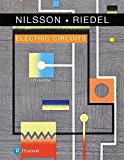
a.
Find the maximum amplitude of the voltage.
a.
Answer to Problem 1P
The maximum amplitude of the voltage is
Explanation of Solution
Given data:
The given sinusoidal voltage is,
Formula used:
Consider the general expression for sinusoidal voltage.
Here,
Calculation:
Compare equation (1) with equation (2), that is
Conclusion:
Thus, the maximum amplitude of the voltage is
b.
Find the value of frequency in hertz.
b.
Answer to Problem 1P
The value of frequency in hertz is
Explanation of Solution
Calculation:
Compare equation (1) with equation (2), that is
Conclusion:
Thus, the value of frequency in hertz is
c.
Find the value of frequency in radians per second.
c.
Answer to Problem 1P
The value of frequency in radians per second is
Explanation of Solution
Calculation:
Compare equation (1) with equation (2), that is
Conclusion:
Thus, the value of frequency in radians per second is
d.
Find the value of phase angle in radians.
d.
Answer to Problem 1P
The value of phase angle in radians is
Explanation of Solution
Calculation:
Compare equation (1) with equation (2), that is
Conclusion:
Thus, the value of phase angle in radians is
e.
Find the value of phase angle in degrees.
e.
Answer to Problem 1P
The value of phase angle in degrees is
Explanation of Solution
Calculation:
Compare equation (1) with equation (2), that is
Conclusion:
Thus, the value of phase angle in degrees is
f.
Find the value of period in milliseconds.
f.
Answer to Problem 1P
The value of period in milliseconds is
Explanation of Solution
Calculation:
Consider the general expression for time period.
Substitute
Conclusion:
Thus, the value of period in milliseconds is
g.
Find the value of first time that obtained after
g.
Answer to Problem 1P
The value of first time that obtained after
Explanation of Solution
Calculation:
Substitute
Simplify the equation as follows.
Conclusion:
Thus, the value of first time that obtained after
h.
Find the expression of
h.
Answer to Problem 1P
The expression of
Explanation of Solution
Calculation:
As the sinusoidal function is shifted
Conclusion:
Thus, the expression of
i.
Find the minimum number of milliseconds taken by a function to shift towards left, when
i.
Answer to Problem 1P
The minimum number of milliseconds taken by a function to shift towards left, when
Explanation of Solution
Calculation:
Substitute
Simplify the equation as follows.
Rearrange the equation as follows.
Conclusion:
Thus, the minimum number of milliseconds taken by a function to shift towards left, when
Want to see more full solutions like this?
Chapter 9 Solutions
Electric Circuits Plus Mastering Engineering with Pearson eText 2.0 - Access Card Package (11th Edition) (What's New in Engineering)
- Solve the following nonlinear system using Newton's method 1 f1(x1, x2, x3)=3x₁ = cos(x2x3) - - 2 f2(x1, x2, x3) = x² - 81(x2 +0.1)² + sin x3 + 1.06 f3(x1, x2, x3) = ex1x2 +20x3 + Using x (0) X1 X2 X3 10π-3 3 = 0.1, 0.1, 0.1 as initial conditioarrow_forwardUse Newton-Raphson method to solve the system x² - 2x-y+0.5= 0 x² + 4y² 4 = 0 - with the starting value (xo,yo) = (2,0.25) and two iteration number.arrow_forwardReversing 3⍉ Motors using manual starters with wiring diagram of forward contacts and reverse contacts.arrow_forward
- Determine (a) the input impedance and (b) the reflectedimpedance, both at terminals (a,b) in the circuit of Fig. P11.14.arrow_forward11.4 Determine Vout in the circuit shown in Fig. P11.4.arrow_forwardFor the circuit in Fig. P11.1, determine (a) iL(t) and (b) theaverage power dissipated in RL.arrow_forward
- Design a synchronous Up/Down counter to produce the following sequence (4 9 2,0,7,6,3,1,5) using T flip-flop. The counter should count up when Up/Down =1, and down when Up/Down = 0.arrow_forwardSolve the following systems using Gauss Seidal and Jacobi iteration methods for n=8 and initial values X0=(000). - 2x16x2 x3 = -38 - -3x1 x2+7x3 = −34 -8x1 + x2 - 2x3 = -20arrow_forwardSolve the following systems using Gauss Seidal and Jacobi iteration methods for n=8 and initial values Xº=(000). 3x12x2x3 = 4 - 2x1 x2 + 2x3 = 10 x13x24x3 = 4arrow_forward
- Use Newton-Raphson method to solve the system x² - 2x-y+0.5= 0 x² + 4y² 4 = 0 - with the starting value (xo,yo) = (2,0.25) and two iteration number.arrow_forwardSolve the following systems using Gauss Seidal and Jacobi iteration methods for n=8 and initial values X0=(000). - 2x16x2 x3 = -38 - -3x1 x2+7x3 = −34 -8x1 + x2 - 2x3 = -20arrow_forwardSolve the following nonlinear system using Newton's method 1 f1(x1, x2, x3)=3x₁ = cos(x2x3) - - 2 f2(x1, x2, x3) = x² - 81(x2 +0.1)² + sin x3 + 1.06 f3(x1, x2, x3) = ex1x2 +20x3 + Using x (0) X1 X2 X3 10π-3 3 = 0.1, 0.1, 0.1 as initial conditioarrow_forward
 Introductory Circuit Analysis (13th Edition)Electrical EngineeringISBN:9780133923605Author:Robert L. BoylestadPublisher:PEARSON
Introductory Circuit Analysis (13th Edition)Electrical EngineeringISBN:9780133923605Author:Robert L. BoylestadPublisher:PEARSON Delmar's Standard Textbook Of ElectricityElectrical EngineeringISBN:9781337900348Author:Stephen L. HermanPublisher:Cengage Learning
Delmar's Standard Textbook Of ElectricityElectrical EngineeringISBN:9781337900348Author:Stephen L. HermanPublisher:Cengage Learning Programmable Logic ControllersElectrical EngineeringISBN:9780073373843Author:Frank D. PetruzellaPublisher:McGraw-Hill Education
Programmable Logic ControllersElectrical EngineeringISBN:9780073373843Author:Frank D. PetruzellaPublisher:McGraw-Hill Education Fundamentals of Electric CircuitsElectrical EngineeringISBN:9780078028229Author:Charles K Alexander, Matthew SadikuPublisher:McGraw-Hill Education
Fundamentals of Electric CircuitsElectrical EngineeringISBN:9780078028229Author:Charles K Alexander, Matthew SadikuPublisher:McGraw-Hill Education Electric Circuits. (11th Edition)Electrical EngineeringISBN:9780134746968Author:James W. Nilsson, Susan RiedelPublisher:PEARSON
Electric Circuits. (11th Edition)Electrical EngineeringISBN:9780134746968Author:James W. Nilsson, Susan RiedelPublisher:PEARSON Engineering ElectromagneticsElectrical EngineeringISBN:9780078028151Author:Hayt, William H. (william Hart), Jr, BUCK, John A.Publisher:Mcgraw-hill Education,
Engineering ElectromagneticsElectrical EngineeringISBN:9780078028151Author:Hayt, William H. (william Hart), Jr, BUCK, John A.Publisher:Mcgraw-hill Education,





